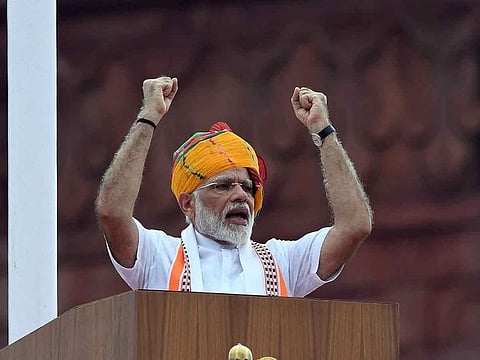How Narendra Modi led a digital revolution in India
The new transformation has changed the mindset and cultural consciousness of the country

Also In This Package
Imagine yourself being part of an online quiz with various questions to assess the world’s best and then being told that the answer to each of these questions is the same — India. Sound implausible, right? So let the facts speak for themselves.
Which country has the world’s largest digital payments ecosystem? With over 25 billion transactions in the year 2020, India is way ahead in digital payments than an equally populous country like China or a country with advanced technology and smart phone penetration like the US.
Which country has the world’s largest tech-based unique identity architecture? With over 1.29 billion digital identity Aadhar Cards issued, India has by far the largest and the best unique identity architecture in the world, based on biometrics.
Which country has the world’s largest and most comprehensive direct benefits transfer ecosystem? With over 320 schemes and a cumulative transfer of more than $230 billion over 7 years, India has developed the world’s best, leakage proof, direct benefits transfer model.
Powered by the JAM trinity of Jan Dhan bank accounts, Aadhar identity and mobile internet connecting the remotest corners of India, the DBT model has revolutionised India’s governance delivery.
Which country has the world’s largest digital marketplace for agri-produce? Launched in 2016, India’s National Agriculture Market or eNAM connects more than 17 million of India’s farmers to a common national digital marketplace where they are able to trade in their agri-produce.
A digital marketplace
Which country has the world’s largest and transparent digital marketplace for regular government purchases? The Government e-Marketplace or the GeM platform now enables over 2 million of India’s entrepreneurs to directly sell their produce in a transparent, marketplace without the hassles of red tape or extraneous considerations.
Which country has the world’s largest and most complete participative governance model? MyGov, India’s participative governance platform has now over 18 million active users regularly participating in framing such important national policies as the National Education Policy and the yearly Government of India financial budget.
Which country houses the world’s largest mobile manufacturing unit? The Samsung Unit near the National Capital of India, with a capacity of 120 million units a year is not just the world’s largest manufacturing unit but also contributes to making India the world’s second largest mobile manufacturing country.
Which country developed and successfully used the world’s largest COVID-19 contact tracing mobile app? The Arogya Setu app, with over 190 million registered users became the world’s most used mobile app in identifying, monitoring and mitigating the spread of COVID-19 pandemic.
Which country is using the world’s largest tech-platform based COVID-19 vaccination drive? The Co-WIN platform that India is using to power its vaccination drive against the COVID-19 pandemic has seamlessly allowed over 328 million vaccines does to be administered in just over 5 months, the largest in the world outside China and at the fastest pace in the world.
Over 20 countries are no looking to emulate this platform that gives real time updates in a transparent dashboard.
So how did this all happen? How did India emerge as the leader in the high technology domain despite India’s many perceived shortcomings and the historical baggage of being a developing nation?
Two words — Digital India
Launched on 1 July 2015, Digital India is perhaps the most successful initiative launched by Prime Minister Narendra Modi. In just a short span of six years, Digital India has become the holdall that on the one hand empowers those left behind and on the other empowers those who innovate and play with the most complex technologies the world has yet seen.
But this has not happened by mistake. In an interactive session with citizens during the launch six years ago, Modi was clear in his views on technology — “Technology empowers the less empowered. If there is a strong force that bring a change in the lives of those on the margins it is technology. It serves as a leveller and a springboard.”
While India missed the Industrial and the Manufacturing revolution due to imperialist and colonising forces, the Digital Revolution has the potential to do to India what the previous revolutions did for the West. The hottest new Start Up in the blockchain technology is from India as is the most talked about EdTech Start Up.
With addition of 15 unicorns in just 2021 alone, India is now the most talked about Start Up ecosystem in this part of the world. In the next two years India will deploy 5G mobile network as well as connect over 600,000 villages through broadband network. The opportunities that this alone will present are immense.
But what is perhaps the most defining contribution of Digital India is the way it has changed the mindset and the cultural consciousness of the country. Indians can now after a very long time, claim to create products and services that are original, replicable, world class and breakthrough technologies.
Innovation is happening not sporadically but in droves. The digital revolution is not geographically limited but is a pan India phenomenon. The government and the private sector have found the perfect balance — the government creates the infrastructure and the light touch regulatory policy and then gets out of the way while the creative energies of private enterprise then take over.
It is as if a critical mass has been breached, a Rubicon has been crossed and in the digital world, India has found a sweet spot. History is witness to the fact that when this happens, it eventually leads to an epochal change. I can happily say that I was in the audience when this change first began on the July 1, 2015.
Sign up for the Daily Briefing
Get the latest news and updates straight to your inbox










